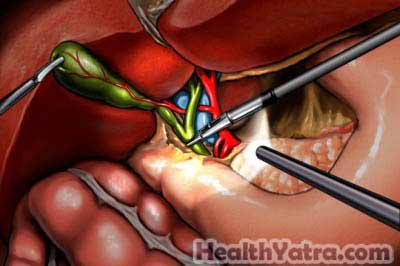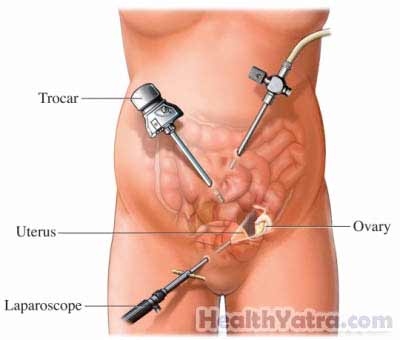সংজ্ঞা
For this type of surgery, a doctor uses robotic arms to operate through small keyhole incisions in the abdomen.
The robotic arms are able to do surgical tasks with an increased range of motion. They also can filter out hand tremor. The special tools translate the doctor’s larger hand movements into smaller ones. This allows delicate work in small spaces.

পদ্ধতির কারণ
Some laparoscopic surgeries that have been successful using robotic techniques include:
- Adrenalectomy —removal of adrenal gland
- Appendectomy —removal of the appendix
- Bariatric surgery —surgery of the stomach to treat obesity
- Cholecystectomy —removal of the gallbladder
- Colorectal procedures
- Hernia repair
- Nephrectomy —removal of a kidney
- Nissen fundoplication —surgical reinforcement of the valve between the esophagus and stomach
- Prostatectomy —removal of the prostate
- Hysterectomy —removal of the uterus (results in infertility)
- Myomectomy —removal of fibroids (noncancerous tumors in the walls of the uterus)
Compared to more traditional procedures, robotic-assisted laparoscopic surgery may result in:
- Less scarring
- Reduced recovery times
- Less সংক্রমণের ঝুঁকি
- Less blood loss
- Reduced trauma to the body
- Shorter hospital stay
- Faster recovery
সম্ভাব্য জটিলতা
Complications are rare, but no procedure is completely free of risk. If you are planning to have a robot-assisted laparoscopic procedure, your doctor will review a list of possible complications, which may include:
- Damage to neighboring organs or structures
- সংক্রমণ
- রক্তপাত
- এনেস্থেশিয়া সংক্রান্ত সমস্যা
- The need to switch to traditional surgical methods (eg, traditional laparoscopic or open surgery)
জটিলতার ঝুঁকি বাড়াতে পারে এমন কিছু কারণের মধ্যে রয়েছে:
জটিলতার ঝুঁকি বাড়াতে পারে এমন কারণগুলির মধ্যে রয়েছে:
- ধূমপান
- প্রাক-বিদ্যমান হার্ট বা ফুসফুসের অবস্থা
- স্থূলতা
- ডায়াবেটিস
- অতিরিক্ত অ্যালকোহল গ্রহণ
- Previous abdominal or pelvic surgery
- নির্দিষ্ট ওষুধের ব্যবহার
পদ্ধতির আগে আপনার ডাক্তারের সাথে এই ঝুঁকিগুলি নিয়ে আলোচনা করতে ভুলবেন না।
কি আশা করছ
পদ্ধতির আগে
Depending on the reason for your surgery, your doctor may do the following:
- শারীরিক পরীক্ষা
- রক্ত পরীক্ষা
- প্রস্রাব পরীক্ষা
- Electrocardiogram (ECG, EKG) —a test that records the electrical currents passing through the heart muscle
- Intravenous pyelogram (IVP) —a type of x-ray that creates images of the kidney, ureters, and bladder by injecting dye into the bloodstream
- Kidneys, ureter, bladder (KUB) —an x-ray of the abdomen
- Abdominal or pelvic ultrasound —a test that uses sound waves to visualize the inside of the body
- CT scan —a type of x-ray that uses a computer to create images of structures inside the abdomen or pelvis
পদ্ধতি পর্যন্ত নেতৃত্ব:
- আপনার ওষুধ সম্পর্কে আপনার ডাক্তারের সঙ্গে কথা বলুন। পদ্ধতির এক সপ্তাহ আগে আপনাকে কিছু ওষুধ খাওয়া বন্ধ করতে বলা হতে পারে, যেমন:
- প্রদাহ বিরোধী ওষুধ (যেমন, অ্যাসপিরিন)
- Blood thinners such as clopidogrel (Plavix) or warfarin (Coumadin)
- Take antibiotics if instructed.
- Take a laxative and/or use an enema to clean out your intestines if instructed.
- Follow a special diet if instructed.
- Shower the night before using antibacterial soap if instructed.
- Arrange for someone to drive you home from the hospital. Also, have someone to help you at home.
- আগের রাতে হালকা খাবার খান। খাওয়া বা মধ্যরাত্রি পরে কিছু পান করবেন না।
এনেস্থেশিয়া
Depending on the type of procedure that you have, you may be given:
- General anesthesia —blocks pain and keeps you asleep through the surgery
- Local anesthesia—just the area that is being operated on is numbed; given as an injection and may also be given with a sedative
পদ্ধতির বর্ণনা
Several small incisions will be made. They are called keyhole incisions. Carbon dioxide gas will be passed into the abdomen to expand it. This will make it easier for the doctor to see.
A small camera will be passed through one of the incisions. This tool is called an endoscope. It lights, magnifies, and projects an image of the organs onto a video screen. The endoscope will be attached to one of the robotic arms. The other arms will hold tools that are able to grasp, cut, dissect, and suture. These may include:
- Forceps
- Scissors
- Dissectors
- Scalpels

The doctor will sit at a console, looking at the images on the screen. Joystick-like hand controls and foot pedals will help to guide the tools. Another doctor will stay by you to adjust the tools as needed. In some cases, organs or tissue might need to be removed. When the procedure is done, the tools will be removed. The doctor will close the incisions with sutures or staples and apply a sterile dressing.
এতে কতক্ষণ সময় লাগবে?
About 1-2 hours (depending on the type of procedure)
এটা কতটা আঘাত করবে?
You will have pain and discomfort during recovery. Your doctor will give you pain medicine. You may also feel bloated or have pain in your shoulder from the gas used during the procedure. This can last up to three days.
গড় হাসপাতালে থাকার
This procedure is done in a hospital setting. The usual length of stay is 1-2 days. Your doctor may choose to keep you longer if you have any problems.
পোস্ট-প্রক্রিয়া যত্ন
When you return home, do the following to help ensure a smooth recovery:
- Wash the incisions with mild soap and water.
- কখন গোসল করা, গোসল করা বা জলে ভিজানো নিরাপদ সে সম্পর্কে আপনার ডাক্তারকে জিজ্ঞাসা করুন।
- Take antibiotics to help prevent infection if instructed.
- Avoid certain medicines.
- Resume normal activities (eg, daily walks) soon. This will promote healing. You will have to avoid other activities, like driving, sexual activity, and strenuous exercise.
- Gradually progress from a liquid to a solid diet.
- To avoid constipation:
- Eat a high-fiber diet.
- প্রচুর পানি পান কর.
- Use stool softeners.
- আপনার ডাক্তারের নির্দেশাবলী অনুসরণ করতে ভুলবেন না।
Depending on the procedure, you should make a full recovery within a few weeks.
আপনার ডাক্তারকে কল করুন
আপনি হাসপাতাল ছেড়ে যাওয়ার পরে, নিম্নলিখিতগুলির মধ্যে যেকোনটি ঘটলে আপনার ডাক্তারের সাথে যোগাযোগ করুন:
- জ্বর এবং ঠাণ্ডা সহ সংক্রমণের লক্ষণ
- Redness, swelling, increasing pain, excessive bleeding, or discharge from an incision site
- Abdominal swelling or pain
- মারাত্মক বমি বমি ভাব বা বমি হওয়া
- Persistent diarrhea or constipation
- Blood in the stool
- আপনার পা, বাছুর বা পায়ে ব্যথা এবং/অথবা ফোলা
- কাশি, শ্বাসকষ্ট, বুকে ব্যথা
- Difficulty urinating, such as pain, burning, urgency, frequency, or persistent bleeding
- Being unable to eat or drink liquids
- Headache, feeling faint or dizzy
- Excessive vaginal bleeding (soaking more than one pad per hour) after a gynecologic procedure
- Persistent or foul smelling vaginal discharge after a gynecologic procedure
- Other worrisome symptoms
জরুরী পরিস্থিতিতে, অবিলম্বে চিকিৎসা সহায়তার জন্য কল করুন।
